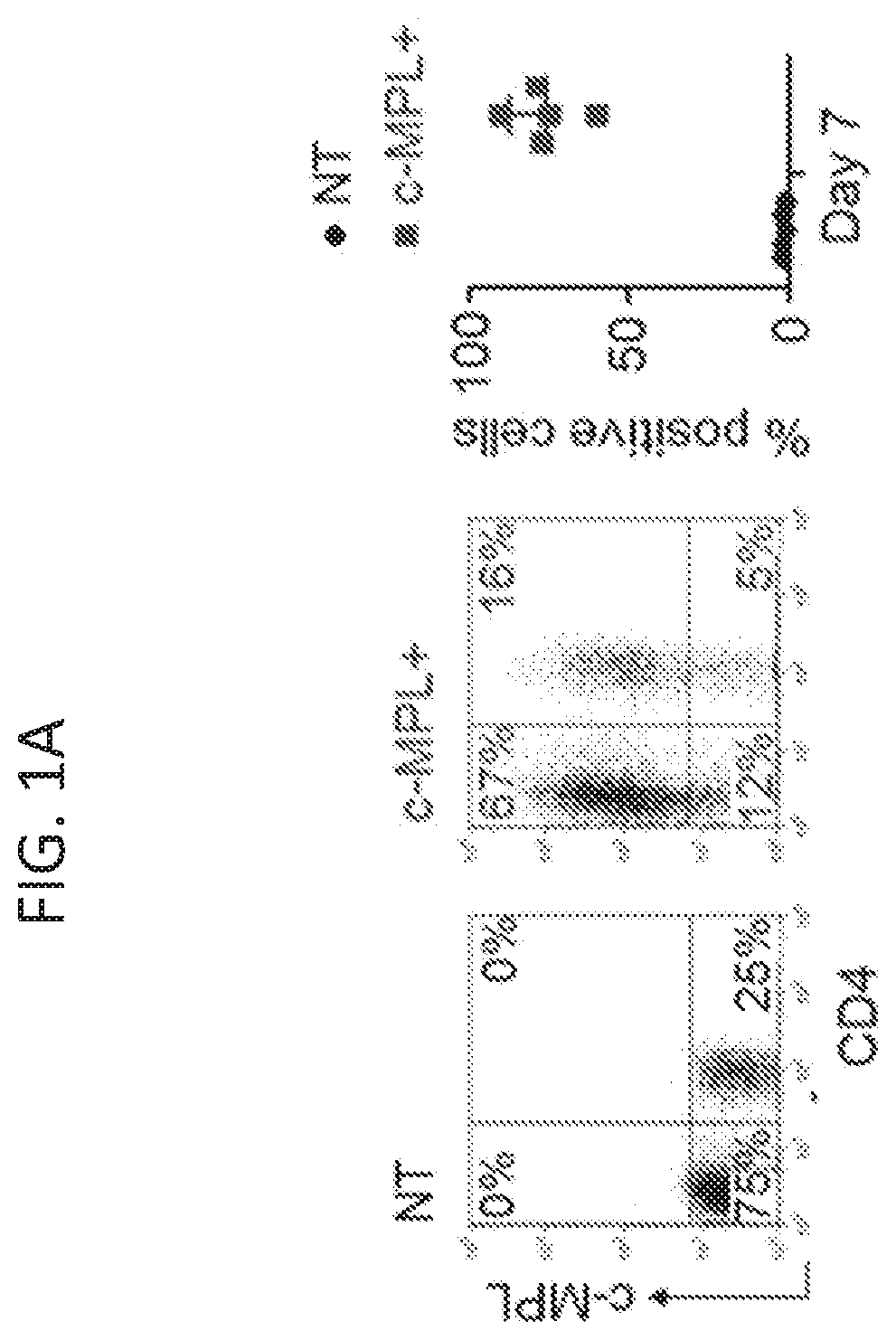TRANSGENIC c-MPL PROVIDES LIGAND-DEPENDENT CO-STIMULATION AND CYTOKINE SIGNALS TO TCR-ENGINEERED T CELLS
a t cell and transgenic technology, applied in the field of cancer medicine, can solve the problems of insufficient sustained anti-tumor activity and ineffective delivery of cytokines to the tumor site, and achieve the effects of improving cytokine signaling, enhancing anti-tumor activity, and efficiently expressed
- Summary
- Abstract
- Description
- Claims
- Application Information
AI Technical Summary
Benefits of technology
Problems solved by technology
Method used
Image
Examples
example 1
C-MPL Expression in Polyclonal T Cells Leads to Agonist-Dependent T Cell Expansion and Persistence
[0144]Adoptively transferred T cell receptor (TCR)-engineered T-cells depend on host-derived co-stimulation and cytokine signals for their full and sustained activation. However, in cancer patients both signals are frequently impaired. The present disclosure provides a novel strategy that combines both essential signals in one transgene by expressing the non-lymphoid hematopoietic growth factor receptor c-MPL (myeloproliferative leukemia), the receptor for thrombopoietin (TPO), in T-cells. C-MPL signaling activates pathways shared with conventional co-stimulatory and cytokine receptor signaling. Thus, it was considered that host-derived TPO, present in the tumor microenvironment, or FDA-approved pharmacological c-MPL agonists could deliver both signals to c-MPL engineered TCR-transgenic T-cells. As shown herein, c-MPL+ polyclonal T cells expand and proliferate in response to TPO, and pe...
example 2
C-MPL in Tumor-Targeted TCR-Transgenic T Cells Provides Agonist-Dependent Enhancement of Anti-Tumor Function In Vitro
[0146]Previously described survivin-specific TCR-transgenic T cells were modified with c-MPL to assess agonist-dependent T cell expansion and enhanced anti-tumor function (Arber et al., 2015). CD8+ selected activated T cells were left non-transduced (NT), single transduced with the survivin-TCR (FIG. 7B), or co-transduced with the survivin-TCR and c-MPL vectors (FIGS. 7A-7B). Transductions were highly efficient (FIG. 2A), resulting in 58.9±12.6% TCR+c-MPL+, 19.1±9.7% TCR+c-MPL− and 12.1±5.5% TCR-c-MPL+ cells in the co-transduced group and 86.1±6.3% TCR+ cells in the TCR+ group (mean±SD, n=13, FIG. 2A). Next, it was tested if rhTPO supports antigen-specific T cell expansion of TCR+c-MPL+ T cells by stimulating TCR+ or TCR+c-MPL+ T cells with irradiated survivin peptide-pulsed artificial antigen presenting cells (aAPCs) in the presence of increasing concentrations of rh...
example 3
C-MPL Activation Enables Sequential Killing Activity and Expansion of Central Memory TCR+C-MPL+ T Cells
[0148]To study the effects of c-MPL signaling in TCR+ T cells in the presence of high tumor load, T cells were transduced with a polycistronic vector expressing both the TCR and c-MPL in a single construct (FIG. 7C). Viral copy number per cell was 4.87±2.48 copies (n=3, mean±SD) (FIG. 7D). TCR+c-MPL+ T cells were added to BV173 leukemia cells, and added these target cells back every 3-4 days to culture replicate wells up to eight times (FIG. 3A). TCR+c-MPL+ T cells in the absence of cytokines or with plate-bound CD28 alone killed only 1-2 times, while addition of rhTPO, EP, IL2 or plate-bound CD28+IL2 significantly increased the repetitive killing capacity of the cells up to 8 times (FIG. 3A, left), and also significantly enhanced T cell expansion (FIG. 3A, right). Time to cell killing was analyzed by Kaplan-Meier analysis and revealed consistent outcomes (overall p<0.0001). In add...
PUM
 Login to View More
Login to View More Abstract
Description
Claims
Application Information
 Login to View More
Login to View More - R&D
- Intellectual Property
- Life Sciences
- Materials
- Tech Scout
- Unparalleled Data Quality
- Higher Quality Content
- 60% Fewer Hallucinations
Browse by: Latest US Patents, China's latest patents, Technical Efficacy Thesaurus, Application Domain, Technology Topic, Popular Technical Reports.
© 2025 PatSnap. All rights reserved.Legal|Privacy policy|Modern Slavery Act Transparency Statement|Sitemap|About US| Contact US: help@patsnap.com



